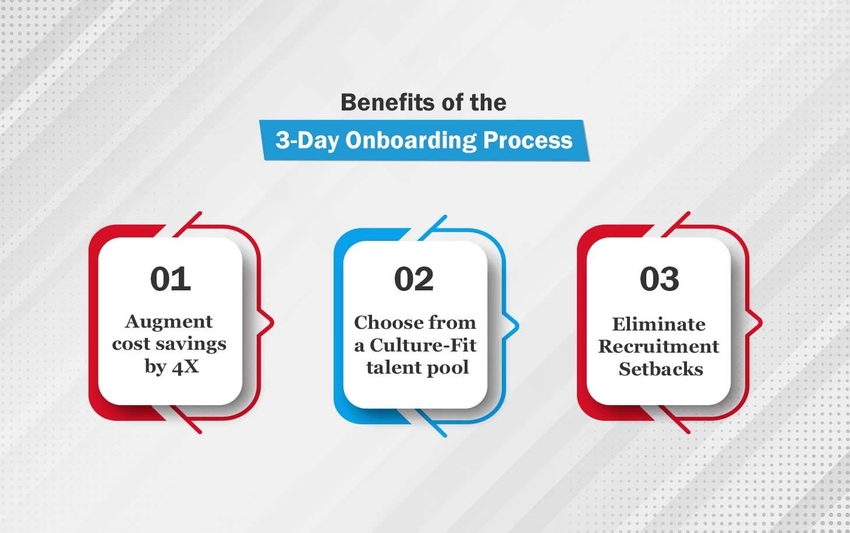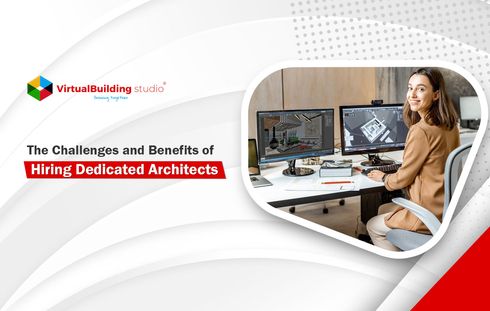
For the Architecture, Engineering, and Construction industry, an employee is the backbone that drives creativity, innovation, and collaboration in the company. Recruiting and onboarding highly skilled and efficient employees forms a strong foundation for building a committed workforce for a company.
Looking at the Post-pandemic statistics, the AIA Chief Economist, Kermit Baker warned, "Since demand for design projects has been healthy over the last year, recruiting architectural staff to keep up with project workloads has been a growing concern for firms".
The AEC industry experiences a concerning gap between existing job vacancies and trained professionals suitable for the role. Operating with convoluted hiring and retention processes will create multiple challenges for the companies, resulting in shortfalls and missed opportunities.
A Forbes article by Tracy Brower, a sociologist and author of The Secrets to Happiness at Work recommended, “sharing key but explicit information about the company’s structure, roles, and hierarchies, and what is expected of staff in meetings, presentations, and thinking sessions”, for a fruitful hiring and onboarding process.
Hiring and Retention Challenges in the AEC industry: A Tedious battle
Hiring is an imperative process for the seamless functioning of the AEC industry. Increasing labor costs, insufficient technically proficient staff, high turnover rates, and compromised work quality are not just nightmares for the AEC industry but a harsh reality for running a business. Despite receiving competitive wages, the staff can leave for various reasons beyond the employer's control.
As per a research report by the Engineering Management Institute, 96% of the surveyed industry leaders share how the shortage of skilled professionals will impede their company growth in 2024. A McKinsey analysis report says, “As per the Infrastructure Investment and Jobs Act (IIJA), spending increases will result in a shortfall of 40,000 engineering and technical services workers in 2027 and another 40,000 in 2028”.
According to the findings of the Engineering Management Institute, the major reasons for AEC professionals quitting the industry can be:
- Expect a Competitive Salary (40%)
- Looking for a flexible work schedule (25%)
- Wanting Career Advancement (53%)
- Increased Stress levels and not feeling valued at work (33%)
The Major Hiring and Retention Challenges faced by the AEC industry are-
Dwindling Talent Pool
- The demand for AEC professionals continues to rise with the simultaneous dwindling of the talented labor pool, intensifying competition among firms to hire top-tier talent.
- According to the National Center for Construction Education & Research, approximately 41% of the current construction workforce, including a significant portion in management roles, is expected to retire by 2031.
- It implies a vast reduction in the talent pool of experienced mentors, necessitating the need to embrace a unique work culture and commitment to employee development by the AEC firms.
More Job Vacancies, Less Qualified Professionals
- Recruiters are facing many challenges in finding efficient professionals to join the company’s workforce, even for easy-to-fill positions like project engineers, project managers, and equipment operators.
- Onboarding young professionals with a lack of soft skills, including communication, strategic thinking, building relationships, leadership, and problem-solving, rather results in creating setbacks for the company than contributing to growth.
Tight Project Budgets
- Another challenge is the tightening of project budgets due to economic fluctuations, continued supply chain disruptions, and rising inflation.
- The arduous task for the firms is to strike a balance between maintaining the quality of talent acquisition and staying within a decided budget.
- Particularly, small-scale AEC firms struggle with this situation while competing against large-scale companies with big budgets.
As the economy broadens, architecture and construction firms are battling to attract and retain staff. Now, how do you deal with these challenges and build a nourishing foundation for the company? The first likely hurdle to meet the future goals is Hire dedicated architects and pursue a healthy onboarding process.
A report by Brandon Hall Group, an analytics firm suggested that organizations with a strong onboarding process enhance new hire retention by 82% and productivity by over 70%.
What is Onboarding?
Onboarding is an organized set of procedures designed to accommodate new hires into a company. It involves introductory orientation, employee familiarization with the company's hierarchy and culture, training and cooling period, and developing an understanding of the goals and principles of the company.
The onboarding time can vary from 45 days to 6 months, depending on the company’s policies and work culture. As per a report by BambooHR, 44% of the new hires actively regret their decision to join the company within the first seven days, and after the first 30 days, 70% of the new hires will officially decide to exit or stay.
The question that arises now is, What should be done to take control of the situation?
Now comes into the picture a well-planned onboarding process with minimum employee onboarding time.
What if I tell you that one can reduce the onboarding time to 3 days with dedicated and efficient top architects and engineers? Isn’t it interesting? The transition from 45 days to 3 days of onboarding in the AEC industry is crazy but achievable.
Let’s delve deeper to know the details and benefits of 3-day onboarding, and how the AEC industry can integrate this approach to hire dedicated engineers and architects.
What is the 3-day Onboarding Process?
A 3-day onboarding process is a dedicated and systematic approach for hiring experienced and competent professionals into the company within just three days, eliminating the hassle of interviewing, training, and reviewing.
This process enables the companies to hire dedicated architects and engineers from the pool of the top 1% of architects and engineers who can inculcate their unique skill sets and expertise to the projects remotely.
The top 1% of architects and engineers are shortlisted through a rigorous process of online tests, HR interviews, written tests, and technical interviews, ensuring that the best ones get onboard.
These professionals are trained to quickly familiarize themselves with the company’s culture, goals, procedures, and expectations to contribute effectively right from the beginning.
How is a 3 - day Onboarding different from a 45-day onboarding process?
For a better understanding of the key differences, here’s a comparative analysis between a 45-day onboarding process and the 3-day onboarding process:
| Points | 45-Day Onboarding | 3-Day Onboarding |
|---|---|---|
| Training Duration | Rigorous and in-depth training over 45 days | Concise training within 3 days |
| Cost | Higher Costs due to long training and integration period | 4 times lesser costs due to short onboarding period |
| Familiarization | Gradual adjustment with people and company’s culture | Quick adjustment with people and company’s culture |
| Efficiency | Slow-paced onboarding leading to delayed results | Rapid onboarding leading to accelerated productivity |
| Candidate Availability | A wide candidate pool, might include less skilled professionals | A selected pool of the top 1% talented architects and engineers |
| Adaptability | New Hires take more time to adapt and settle | New Hires adapt and settle quickly |
| Review Period | A thorough assessment and review period of 45 days | Minimal review period |
Benefits of the 3-Day Onboarding Process
"Burning Candle at both ends”, is an expression that is synonymous with the nature of work in the AEC industry. AEC Professionals are at the grindstone, striving for excellence and quality-driven results within time constraints.

With such expectations and project deliverables at stake, the 3-day onboarding process can be the crowning accomplishment for the company, offering work proficiency accompanied by reduced onboarding time.
Let's explore the benefits of this process -
Augment cost savings by 4X
That’s right! The 3-day onboarding process saves time and decreases the expenditure by 4 times. The companies get access to four top-grade resources at the cost of one for their US-based projects.
With exceptional deliverables and minimized project costs, it essentially caters to the two most crucial attributes of any architectural project; quality and budget.
Choose from a Culture-Fit talent pool.
Only hiring experts does not suffice for sustenance and results, but the cultural compatibility of the new talent is equally significant. The 3-day onboarding process will allow the company to choose from a pool of premium 1% architects and engineers with excellent soft and behavioral skills, who are experienced in working across different cultural backgrounds and are hands-on with adaptation.
Eliminate Recruitment Setbacks
It is a tedious and stressful process for any AEC firm to find a suitable fit without negotiating on skill sets from a vast pool of talented architects and engineers. The 3-day onboarding approach guarantees the recruitment of a top-grade professional with proven track records and without any long-term commitments.
Does this approach and its benefits tickle your curiosity? Are you also intrigued to expand your team of professionals with highly-skilled experts from the top 1% of the AEC industry within a 3-day onboarding time? If Yes, then the answer to all your queries is the Dedicated Resource Model (DRM) by Virtual Building Studio.
What is the DRM solution by Virtual Building Studio?
The Dedicated Resource Model (DRM) by Virtual Building Studio is a comprehensive solution for the AEC industry, facilitating the hiring of the best-suited professionals from the pool of the top 1% of architects and engineers within 3 days.
Distinguishing Features
- Escape the hassle of sourcing, recruiting, training, and retaining talent.
- Achieve 4 times the efficiency at a similar cost.
- Choose from the top 200 architects and engineers with 9 years of work experience.
- Get flexibility in recruiting a single expert with specialized skills or 10 separate professionals across different teams.
- Hire dedicated architects and engineers trained for US-based firms who are ready for immediate joining.
How to Integrate a DRM solution to an AEC project?
Adapting the Dedicated Resource Model (DRM) solution is a three-step process for any AEC firm that is as follows-
- Grab the Phone and Make that Discovery call
- Recruit Architects and Engineers suitable for the Job
- Onboard and Scale as per requirement
A Successful 3-day Onboarding Story with DRM Solution
Expanding the team of dedicated architects and engineers from 1 to 5 with an average onboarding time of 3 days, doesn't that sound strenuous? Not anymore.
One of the many successful executions of DRM solutions was for Tesla - an American multinational automotive and clean energy company. Integrating this solution seamlessly transitioned to an approach that no longer involves reliance on different resources but rather a consistent and skilled team for all tasks.
Not only did the DRM solution save time and simplify the job, but it also resulted in 72% savings on the total cost spent earlier by Tesla for hiring multiple different resources from the USA.
Conclusion
Avoiding recruitment delays and minimizing the hiring time is essential in the AEC industry for maintaining competitive advantage, monitoring project timelines, and managing costs. By leveraging solutions such as DRM, companies can expand their talent pool and enhance hiring efficiency.
If you’re also looking to employ such solutions for your business to thrive and expedite results, get on a discovery call with team VBS.




